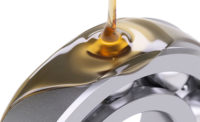Lubricants: a more perplexing decision
Selecting the optimal lubricants is more perplexing for protein processors as newer, powerful food-grade greases become plentiful.




Meat and poultry processors’ focus on running efficient plant operations while also maximizing food safety is making the selection of lubricants increasingly complicated.
With a growing array of food-grade greases approved for incidental food contact, plant operators face the arduous task of pinpointing the most effective products for their specific equipment. Such lubricants carry the H1 category code from NSF International, an Ann Arbor, Mich.-based certifier of products and systems.
There are more than 8,770 H1 lubricants registered with NSF International and the number is growing by the hundreds each year, says Ashlee Breitner, NSF business unit manager for the Nonfoods Compound Program.
“Food safety awareness, which is strong in the U. S. and Europe, is increasing in other countries and that will lead additional suppliers to produce and register high-quality food safety lubricants,” she says.
The food-grade greases are intended to prevent machine wear and corrosion, withstand high temperatures and resist water, and product quality is increasing, says Chuck Coe, president of Grease Technology Solutions LLC, a Manassas, Va.-based consulting and training firm.
More of the lubricants are composed of calcium sulfonate greases, which offer better rust protection and water resistance, have stronger load-carrying capabilities and don’t require as many additives as the traditional aluminum complex greases, he says.
To leverage the ideal greases for their distinct operations, Coe recommends processors have independent labs test the properties of the lubricants under consideration. He cautions that product data sheets from suppliers often vary in the amount of information presented and some performance claims can be exaggerated.
Meat and poultry processors also can compare effectiveness by using different greases under controlled conditions within plants, Coe says.
Sorting through the supplies
“Lube formulation technology has evolved dramatically and it is complex for user organizations to select the greases with the optimum viscosity, base oils and additive systems,” says Jim Fitch, chief executive officer of Noria Corp., a Tulsa, Okla.-based lubrication consulting and training firm. “There are all kinds of product suppliers making all kinds of claims, making it difficult for an asset owner to know what to do.”
Fitch agrees it is crucial for machine operators to work with neutral parties to select the best food-grade greases.
Processing plants with a variety of machines may also require different lubes based on the unique characteristics of each apparatus.
“It is easy for a processor to spend too much money or too little money on lubricants,” Fitch says. “There are premium and economy offerings and it is important to know the best products to fit into gear drives, conveyors or compressor systems.”
Food-grade greases, meanwhile, will continue to improve and future launches will feature products with a longer performance life; more effective additives, base oils and thickeners; and the greater use of calcium sulfonate, he forecasts.
“More food processors will be using H1 lubricants,” Coe says. “Better items are available and food recalls are driving operators to look at newer greases, and driving suppliers to make additional product improvements.“
The launch of more capable food-grade greases will help strengthen and safeguard plant operations, provided that operators skillfully analyze and select the prime choices from the growing array of options.
Looking for a reprint of this article?
From high-res PDFs to custom plaques, order your copy today!










